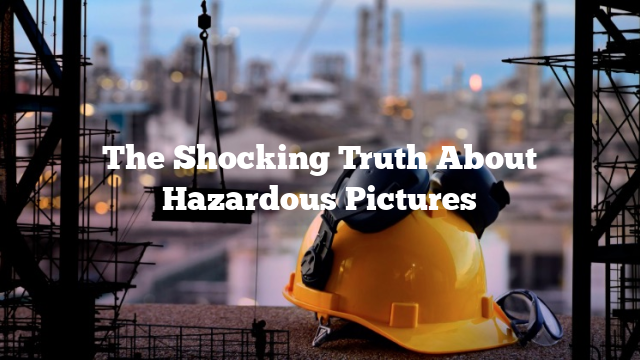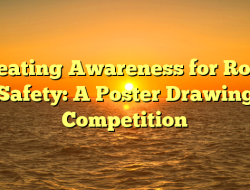Hazards Pictures: Understanding the Risks and Importance of Visual Communication
In today’s world, hazards are everywhere. From construction sites to chemical plants, there are various risks that people face on a daily basis. In order to mitigate these risks, it is important to communicate them effectively. One way to do this is through the use of hazards pictures. In this article, we will discuss what hazards pictures are, why they are important, and provide tips and tutorials on how to create effective visuals to communicate risks.
What are Hazards Pictures?
Hazards pictures are visual representations of potential risks or hazards in a specific environment. They are often used in safety manuals, training materials, and instructional signage to communicate potential risks to individuals in the workplace or public areas. These pictures can include illustrations, photographs, or diagrams that accurately depict the potential hazards in a specific area.
Why Are Hazards Pictures Important?
Hazards pictures are important because they provide a clear and concise way to communicate risks to individuals. Visual communication is often more effective than written or verbal communication, as it allows individuals to quickly and easily understand potential hazards in their environment. This can help to prevent accidents, injuries, and other negative consequences that may result from not understanding potential risks.
Facts About Hazards Pictures
– According to OSHA, there were over 5,000 workplace fatalities in the United States in 2019.
– 15% of workplace fatalities in 2019 were due to slips, trips, and falls.
– In 2018, there were over 2.8 million nonfatal workplace injuries and illnesses reported in the United States.
– Effective safety communication can reduce workplace injuries by up to 80%.
Listicle: Common Hazards Pictures to Include in Workplace Safety Materials
1. Slips, Trips, and Falls
2. Hazardous Chemicals
3. Electrical Hazards
4. Heavy Machinery
5. Fire Hazards
Tutorial of Hazards Pictures
When creating hazards pictures, it is important to accurately depict potential risks in a specific environment. This can be done through the use of illustrations, photographs, or diagrams. Here are some basic steps to follow when creating hazards pictures:
1. Identify the potential hazards in the environment.
2. Determine the best way to visually represent these hazards.
3. Create the hazards pictures using appropriate software or tools.
4. Test the hazards pictures with individuals in the environment to ensure they accurately depict potential risks.
Tips of Hazards Pictures
1. Use clear and concise language to describe potential risks.
2. Ensure that hazards pictures are easily visible and located in areas where people will see them.
3. Regularly update hazards pictures to ensure they accurately depict potential risks in the environment.
4. Use color and contrast to make hazards pictures stand out and grab people’s attention.
Question and Answer of Hazards Pictures
Q: What are the benefits of using hazards pictures in workplace safety materials?
A: Hazards pictures provide a clear and concise way to communicate potential risks to individuals, which can help to prevent accidents and injuries.
Q: How often should hazards pictures be updated?
A: Hazards pictures should be updated regularly to ensure they accurately depict potential risks in the environment.
Q: What types of hazards pictures are most effective?
A: Hazards pictures that use clear and concise language, are easily visible, and use color and contrast to grab people’s attention are most effective.
Q: How can hazards pictures be tested for effectiveness?
A: Hazards pictures can be tested by showing them to individuals in the environment and asking them if they accurately depict potential risks.
Conclusion of Hazards Pictures
Hazards pictures are a crucial component of workplace safety materials. They provide a clear and concise way to communicate potential risks to individuals in a specific environment. By following the tips and tutorials provided in this article, you can create effective hazards pictures that accurately depict potential risks and help to prevent accidents and injuries. Remember, effective safety communication can reduce workplace injuries by up to 80%, so take the time to create effective hazards pictures that will keep everyone safe.
Recommendations:
- Face Shield Free Images If you're looking for face shield free images pictures information related to the face shield free images interest, you have visit the right site. Our website frequently gives you suggestions…
- Safety Inspection Report Format Safety inspection report forms are forms that are used by professionals to report on the kind of safety violations if there are any of certain establishments by conducting a thorough…
- Safety Inspection Report For Construction Site Once corrected record corrective action and date next to item. Yes no na date corrected. 22 Sample Construction Report Templates Word Docs Pages Free Be fitted with suitable safety hoops…
- Safety Inspection Vehicle Missouris motor vehicle safety inspection program requires each vehicle for professional or personal use to go through a series of checks to validate its safety. The program is overseen by…
- Construction Safety Inspection Checklist Template It can be completed in a single inspection or over a series of shorter inspections. Includes checks for first aid facilities fire prevention emergencies site security ppe and more. Construction…
- Huge Safety Slogans Complete List Made Your Safety… Browse through the safety slogans in 2022 suggestions below. The safety slogans is one of Safety Communication method which successful of safety campaign was measured. So Safety Slogans is so…
- 10 Essential Road Safety Measures to Prevent Accidents Introduction 🚦 Did you know that road accidents are one of the leading causes of death worldwide? Every year, millions of lives are lost due to reckless driving and a…
- Safety Quotes Funny Try being a little creative and your message gets across. A big thank you to all of our readers who have contributed some excellent. Funny Workplace Safety Pictures Safety Slogans…
- Safety Data Sheet Sds A safety data sheet sds material safety data sheet msds or product safety data sheet psds are documents that list information relating to occupational safety and health for the use…
- Ghs Safety Data Sheet Sections Ghs has also set the minimum info required for each section. Core content of a ghs safety data sheet. Ghs Safety Data Sheet In 2012 the us adopted the 16…
- The Importance of Traffic Rules: Exploring the… Introduction 🚦 Are you tired of getting confused by traffic rules while driving? Do you often find yourself struggling to remember basic road signs and regulations? Well, worry no more!…
- 10 Essential Industrial Safety Posters Every Workplace Needs Introduction: Safety is a top priority in any industrial environment, and the right safety posters can help remind workers of the potential hazards and the steps they can take to…
- Safety Inspection Checklist Template It covers the owner and vehicle details including the complete name of the vehicle owner home address email club membership if there is model chassis no engine no make year…
- Construction Safety Topics Itll serve your people and your company well well into the future. Toolbox talks for osha safety and health. Construction Safety Topics Construction tool box talks. Construction safety topics. Fresh…
- Electrical Safety Inspection Form General safety checklist for electrical inspections cont. A mobile inspection app such as iauditor can digitize your electrical safety forms and enable you to conduct inspections faster on your hand…
- Site Safety Inspection Checklist They will give you some indication of where you should begin action. Weekly site safety inspection checklist. Jobsite Safety Inspection Checklist Mcaa Place next to each item that is satisfactoryplace…
- Workplace Safety Inspection Checklist Template Use our professionally designed workplace safety inspection checklist template that you can download instantly. After you have used it a couple of times you may wish to modify it so…
- Food Safety Day Logo Practical realistic approaches to identify reduce risks threats allergens microbial contamination fraud vulnerabilities across the supply chain business utilising innovative scientific methods robust risk assessments technological advancements to protect consumer…
- The Importance of Telugu Safety Posters in Promoting… Introduction Imagine a scenario where you walk into a workplace or public space and see safety posters written in a language you don't understand. Frustrating, isn't it? This is a…
- The Art of Road Safety: Designing Effective Posters Road Safety Posters: Promoting Safety and Saving Lives 🚦 Road accidents have become a common occurrence in our daily lives. Every year, millions of people die or suffer from injuries…
- Safety Inspection Report Example Page 1 of 3. Formal inspections can take different forms and you and your representatives will need to agree the best methods for your workplace. Safety Report Templates 16 Pdf…
- Construction Jobsite Safety Inspection Form Safety inspections are the most construction safety inspections are the most effective means of identifying hazardous conditions at the worksite. Inspections complete inspections from anywhere on any mobile or tablet…
- 10 Essential Safety Precautions Everyone Should Know Introduction: Safety precautions are the preventive measures that are taken to avoid any harm or injury to people or property. Safety precautions are an essential part of our daily lives,…
- Safety Signs Construction Construction site signs at guaranteed low prices. For bulk order quotes or for more information on which construction sign is the most suitable for your needs please call our customer…
- Construction Site Safety Inspection Checklist The standards referred to are south carolinas occupational safety and health standards for the construction industry as adopted from 29 cfr code of federal regulations part. Some construction companies will…
- Creating an Effective Road Safety Chart: Tips and Techniques Road Safety Chart Drawing: A Complete Guide to Creating and Maintaining Safe Roads Introduction: Road safety is a major concern for everyone, whether you are a driver, pedestrian, or cyclist.…
- Safety Inspection Checklist Pdf This template can be used to audit training programs and emergency and safety procedures. However carefully consider each item as you come to it and then make your decision. Office…
- Power Plant Safety Topics The use of anhydrous ammonia could be a risk at another facility. A 53 year old journeyman wireman was electrocuted when he contacted two energized 69 kv bus terminals at…
- Construction Site Safety Topics Site organisation everything you need to know about organising a safe and healthy construction site. The department of labor does not endorse takes no responsibility for and exercises no control…
- Sample Of Safety Inspection Checklist There are several ways to perform safety inspections of a workplace task or job. Safety inspection checklist buildingdepartments. 18 Inspection Checklist Examples Samples Pdf Word Pages The best checklist for…
Advertisement
Scroll to Continue With Content




